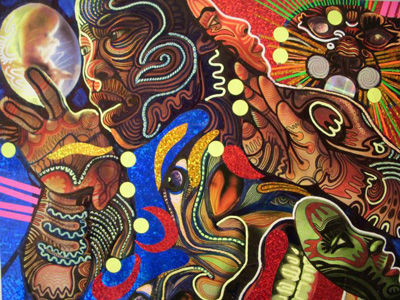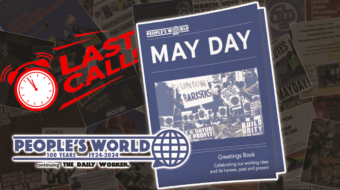
Can oppressed groups resurrect their own suppressed histories through a museum?
What has been the historical role of race and ethnicity in the development of the natural history museum?
Can anthropology, which often provided intellectual cover for white supremacy, play a positive role in the “decolonization” of museum space?
These questions and more were dealt with at “(Re)Presenting America: the Evolution of Culturally Specific Museums,” a symposium at the National Museum of the American Indian in Washington, April 25.
A year ago, the National Museum of the American Latino Commission issued a report entitled “To Illuminate the American Story for All,” recommending the establishment of a Smithsonian National Museum of the American Latino. A campaign was immediately launched by the Friends of the National Museum of the American Latino to “create a museum in our nation’s capital to educate, inspire and encourage respect and understanding of the richness and diversity of the American Latino experience within the U.S. and its territories by highlighting the contributions made by Latino leaders, pioneers and communities to the American way of life.”
The American Latino Museum has strong advocates in Rep. Xavier Becerra, D-Calif., and Sen. Bob Menendez, D-N.J., who in turn gathered support from 22 other members of Congress and sent a letter calling for inclusion of language in support of the museum in the upcoming appropriations bill.
The “(Re)Presenting America” event was organized by the Smithsonian Institution to provide a forum to address the issues surrounding “ethnic” or “culturally specific” museums – whether they have the potential to provide genuine cultural resources to the represented peoples, and the ability to enrich and enlighten the broader, diverse population, fostering greater understanding.
Speakers addressed the idea that the mushrooming of ethnically diverse museums could lead to cultural “Balkanization” that contributes to isolation of racial and ethnic groups. They observed that traditional museums have not represented the diverse histories of our multicultural population.
The symposium, moderated by PBS’ Ray Suarez, began with an interview with an actor portraying the first secretary of the Smithsonian Institute, Joseph Henry. While this format may be considered corny (think Steve Allen’s “Meeting of Minds”) the interview was fascinating.
“Joseph Henry” spoke about Smithsonian-sponsored anthropologist Lewis Henry Morgan’s breakthrough 19th century study on the development of human culture, “Ancient Society.” Morgan, highly influenced by Darwin, expounded a theory of successive stages in social evolution: “savagery,” “barbarism,” and “civilization.” Karl Marx’s collaborator, Frederick Engels, elaborated on Morgan’s theories in his book, “Origin of the Family, Private Property and the State.” Although the names of the stages have been dropped (due to their pejorative nature), Morgan’s and Engels’ ideas about social development still serve as the basis of anthropological investigation today.
The interview also confronted some of the racial issues surrounding the beginnings of anthropology and the natural history museum.
For example, the author of the Dred Scott decision, the 1857 Supreme Court ruling that slaves or their descendants were not protected by the Constitution, was a chancellor of the Smithsonian. During the Civil War, the Smithsonian didn’t take sides, but the Southern states withdrew financial support during the war, nearly bankrupting the Smithsonian. Frederick Douglass was prevented from speaking at the Smithsonian because he was black.
Rutgers University professor Clement Price spoke about the evolution of the natural history museum, and its potential to inform social change. Price took issue with the idea that museums are essentially part of the establishment – “You can’t take down the master’s house using the master’s tools” – and therefore cannot play a liberatory role for oppressed minorities. He said museums could, in fact, counter the “master narrative,” with its depoliticized past, by providing a space for “remembering” the experiences of forgotten or marginalized peoples.
Just such a space was realized recently in the opening of the Jim Crow Museum of Racist Memorabilia at Ferris State University, in Big Rapids, Mich. The museum serves to “remember” America’s white supremacist history: an ongoing, sometimes overt, sometimes covert racism that oppresses all peoples of color. The collection consists of objects, signs, images, and other material that demean African Americans, from slavery days to the present (including racist representations of President Obama).
The Jim Crow Museum could serve as an example of the “anti-museum” suggested by another speaker, David Hurst Thomas, curator of the American Museum of Natural History. It takes “the master’s tools” (racist propaganda) and re-contextualizes them to question the white supremacist order. Thomas pointed out that in the past, the natural history museum served as the “ugly edge of Manifest Destiny.” For example, relics and remains of Native Americans were displayed next to dinosaur fossils, suggesting that indigenous cultures are vestigial, falling off the map of history.
As racial and ethnic groups organized to fight for equality, many social institutions, including museums, have been forced to change. Native Americans pushed for a civic institution that expressed their living history, instead of a repository for fossils and relics, and the National Museum of the American Indian was born. Thomas advocated, with the affirmation of the symposium’s other participants, the concept of a “museum different,” not a temple to the solitary voice of the anthropologist, but a forum for an open conversation about the multiplicity of experiences of our diverse people.
Image: National Museum of the American Indian

MOST POPULAR TODAY

High Court essentially bans demonstrations, freedom of assembly in Deep South

UN warns that Israel is still blocking humanitarian aid to Gaza

Resource wars rage in eastern Congo, but U.S. capitalism only sees investment opportunity

U.S. imperialism’s ‘ironclad’ support for Israel increases fascist danger at home







Comments